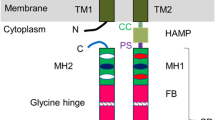Abstract
Bacterial chemotaxis provides a simple model system for the more complex sensory responses of multicellular eukaryotic organisms1. In Escherichia coli, methylation and demethylation of four related membrane proteins, the methyl-accepting chemotaxis proteins (or MCPs), is central to chemotactic sensing and signal transduction2. Three of these proteins, Tar, Tsr and Trg, have been assigned specific roles in chemotaxis. However, the role of the fourth MCP, Tap, has remained obscure3. We demonstrate here that Tap functions as a conventional signal transducer, enabling the cell to respond chemotactically to dipeptides. This provides the first evidence of specific bacterial chemotaxis towards peptides. Peptide taxis requires the function of a periplasmic component of the dipeptide permease. This protein represents the first example of a periplasmic chemoreceptor that does not have a sugar substrate.
Similar content being viewed by others
References
Koshland, D. E. Jr Bacterial Chemotaxis as a Model Behavioral System (Raven, New York, 1980).
Hazelbauer, G. L. & Harayama, S. Int. Rev. Cytol. 81, 33–70 (1983).
Slocum, M. K. & Parkinson, J. S. J. Bact. 163, 586–594 (1985).
Wang, E. A. & Koshland, D. E. Jr Proc. natn. Acad. Sci. U.S.A. 77, 7157–7161 (1980).
Hazelbauer, G. L. & Adler, J. Nature 230, 101–104 (1971).
Zukin, R. S., Hartig, P. R. & Koshland, D. E. Jr Biochemistry 18, 5599–5605 (1979).
Mesibov, R. & Adler, J. J. Bact. 112, 315–326 (1972).
Tso, W-W. & Adler, J. J. Bact. 118, 560–576 (1974).
Springer, M. S., Goy, M. F. & Adler, J. Proc. natn. Acad. Sci. U.S.A. 74, 3312–3316 (1977).
Kondoh, H., Ball, C. B. & Adler, J. Proc. natn. Acad. Sci. U.S.A. 76, 260–264 (1977).
Slocum, M. K. & Parkinson, J. S. J. Bact. 155, 565–577 (1983).
Krikos, A., Mutoh, N., Boyd, A. & Simon, M. I. Cell 33, 615–622 (1983).
Boyd, A., Krikos, A. & Simon, M. I. Cell 26, 333–343 (1981).
Higgins, C. F. & Hardie, M. M. J. Bact. 155, 1434–1438 (1983).
Guter, C. A., Morgan, D. G., Osheroff, N. & Staros, J. V. J. biol. Chem. 260, 10812–10816 (1985).
Higgins, C. F. & Gibson, M. M. Meth. Enzym. 125, 365–377 (1986).
Higgins, C. F. Microbiology, 17–20 (ASM, Washington, DC, 1984).
Payne, J. W. (ed.) Microorganisms and Nitrogen Sources, 211–256 (Wiley, Chichester, UK, 1980).
Higgins, C. F., Hardie, M. M., Jamieson, D. J. & Powell, L. M. J. Bact. 153, 830–836 (1983).
Hogarth, B. G. & Higgins, C. F. J. Bact. 153, 1548–1551 (1983).
Hiles, I. D. & Higgins, C. F. (in preparation).
Gibson, M. M., Price, M. & Higgins, C. F. J. Bact. 160, 122–130 (1984).
Jamieson, D. J. & Higgins, C. F. J. Bact. 160, 131–136 (1984).
Parkinson, J. S. & Houts, S. E. J. Bact. 151, 106–113 (1982).
Adler, J. J. gen. Microbiol. 74, 77–91 (1973).
Callahan, A. M. & Parkinson, J. S. J. Bact. 161, 96–104 (1985).
Dahl, M. K. & Manson, M. D. J. Bact. 164, 1057–1063 (1985).
Berg, H. C. & Block, S. M. J. gen. Microbiol. 130, 2915–2920 (1984).
Manson, M. D., Boos, W., Bassford, P. J. & Rasmussen, B. A. J. boil. Chem. 260, 9727–9733 (1985).
Koman, A., Harayama, S. & Hazelbauer, G. L. J. Bact. 138, 739–747 (1979).
Manson, M. D. & Kossman, M. J. Bact. 165, 34–40 (1986).
Ames, G. F.-L. & Higgins, C. F. Trends. biochem. Sci. 8, 97–100 (1983).
Ames, G. F.-L. A. Rev. Biochem. (in the press).
Perry, D. & Gilvarg, C. J. Bact. 160, 943–948 (1984).
Cowell, J. L. J. Bact. 120, 139–146 (1974).
Russo, A. F. & Koshland, D. E. Jr J. Bact. 165, 276–282 (1986).
Author information
Authors and Affiliations
Rights and permissions
About this article
Cite this article
Manson, M., Blank, V., Brade, G. et al. Peptide chemotaxis in E. coli involves the Tap signal transducer and the dipeptide permease. Nature 321, 253–256 (1986). https://doi.org/10.1038/321253a0
Received:
Accepted:
Issue Date:
DOI: https://doi.org/10.1038/321253a0
- Springer Nature Limited
This article is cited by
-
Identification and characterization of the proteolytic flagellin from the common freshwater bacterium Hylemonella gracilis
Scientific Reports (2020)
-
The expression of many chemoreceptor genes depends on the cognate chemoeffector as well as on the growth medium and phase
Current Genetics (2017)
-
Two different mechanisms mediate chemotaxis to inorganic phosphate in Pseudomonas aeruginosa
Scientific Reports (2016)
-
Bacterial chemoreceptors and chemoeffectors
Cellular and Molecular Life Sciences (2015)
-
The Yersinia pestis gcvB gene encodes two small regulatory RNA molecules
BMC Microbiology (2006)





